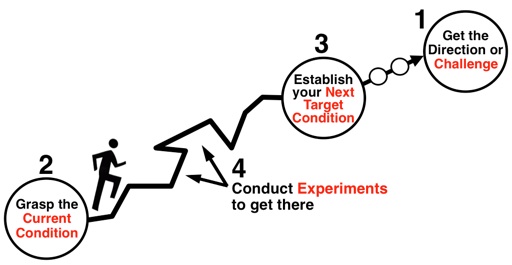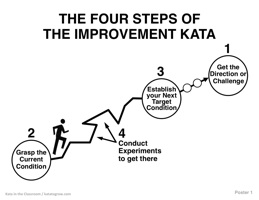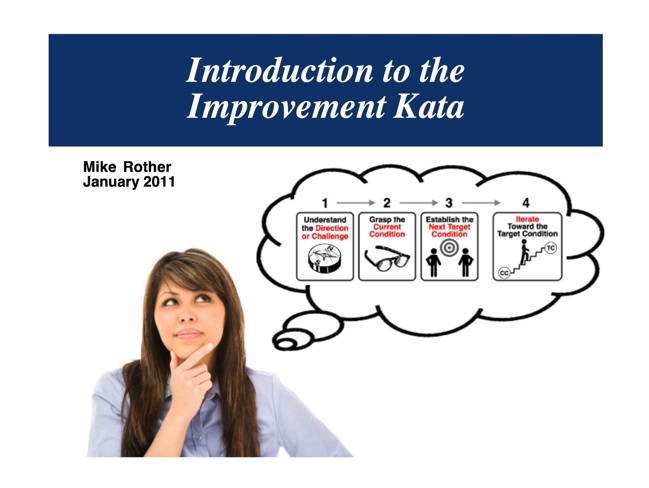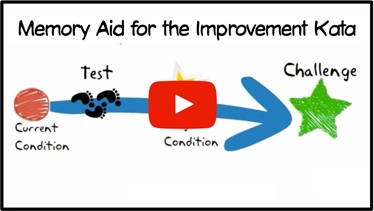3.
Kata Creates
Culture
5.
The TK
Starter Kata


Value Stream Mapping
Supporting Materials

Extras

1.
Improvement Kata

Challenge

2.
Coaching
Kata


4.
Getting
Started

TOYOTA
KATA

The
Improvement
Kata Exercise


The Improvement Kata + Starter Kata
A four-step model of scientific thinking, with practice routines
Today's prescriptions probably won’t fit tomorrow's problems, and the path to a
challenging goal can’t be determined in advance anyway. Your best bet is to practice
a universal means of developing your own solutions (a “meta skill” for any situation).
That’s what you learn by practicing the Improvement Kata.
When conditions are complex and dynamic, scientific thinking may be the best
approach we have for navigating. Scientific thinking means knowing that any idea
should be tested. It means learning to compare what you think (theory) with what
actually happens (evidence), and adjusting based on what you discover from the
difference. It’s a way of thinking that makes us better at reaching difficult goals
through unpredictable territory.
However, scientific thinking is not our natural, default
mode. What normally happens is that our brain
quickly and unconsciously jumps to conclusions.
Scientific thinking is not difficult, it’s just not our habit.
Adults learn scientific thinking through practice. There are simple “Starter Kata” practice
routines for each step of the Improvement Kata, and for coaching, which speed up your
learning and make it easier to scale in teams and organizations. The Improvement Kata
models a pattern of practical, everyday scientific thinking, and the
Starter Kata are what you practice to develop the thinking.
Instructions for the Starter Kata are in the Toyota Kata Practice Guide.
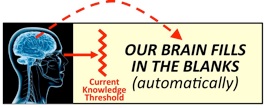

"If you go through the Improvement Kata process
you'll get to where you need to get to. And the
more times you do it the better you will get at it."
~ Jim Huntzinger, President, Lean Frontiers
"Go where there is no path
and leave a trail." ~ Emerson

Excerpt from: Ichijo, Kazuo and Nonaka, Ikujiro, Knowledge Creation and Management: New Challenges for Managers, Oxford University Press, 2006, page 25.
Learning to Learn
Knowledge assets are not just the knowledge already created, such as know-how, patents, technologies, or brands, but also include the knowledge to create knowledge, such as the organizational capability to innovate. Although current views on knowledge assets tend to focus on the former because they are easier to measure and deal with, it is the latter that need more attention because they are the source of new knowledge to be created, and therefore a source of the future value of the firm.
One of the most important knowledge assets for a firm is a firm-specific kata (roughly, "pattern" or "Way of doing things") of dialogues and practices. Nelson and Winter (1982) emphasize the importance of routines for the firm's evolutionary process. Here, we focus on "creative routines" of kata, which make knowledge creation possible by fostering creativity and preserving efficiency.


Improvement Kata Poster
(click image for a pdf)
You can start practicing one Starter Kata today:
-
★ You’re a manager who needs to run a meeting and are wondering how to best do that.
-
★ You would like to add useful (and marketable) skills to your personal portfolio.
-
★ You’re an educator who wants to help students practice critical-thinking STEM skills.
-
★ You want to empower your teams.
-
★ You’re curious about the Improvement Kata.
-
★ You want to develop the necessary mindset to use Lean techniques.
-
★ Your new business is growing and you need a management system.
Take a first mini step today. Print out the Improvement Kata poster and get a few five
question cards. Read through the questions on the card, in the order shown, with your
team, in meetings, etc. You’ll be adding scientific-thinking focus and flow to any meeting.
Five-Question Card
(click the card, or get preprinted cards here)

Click to read about
the TK research
and findings

